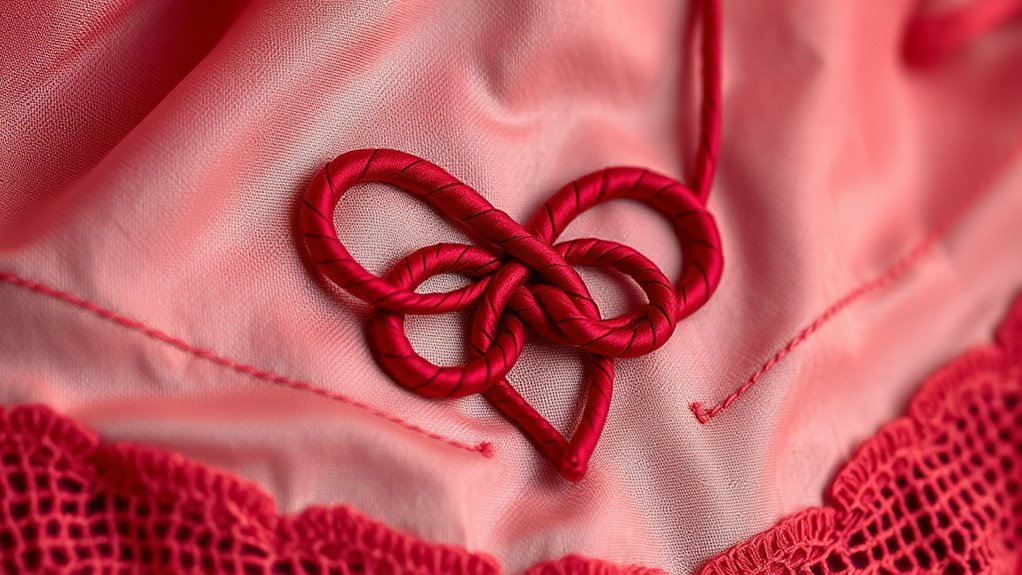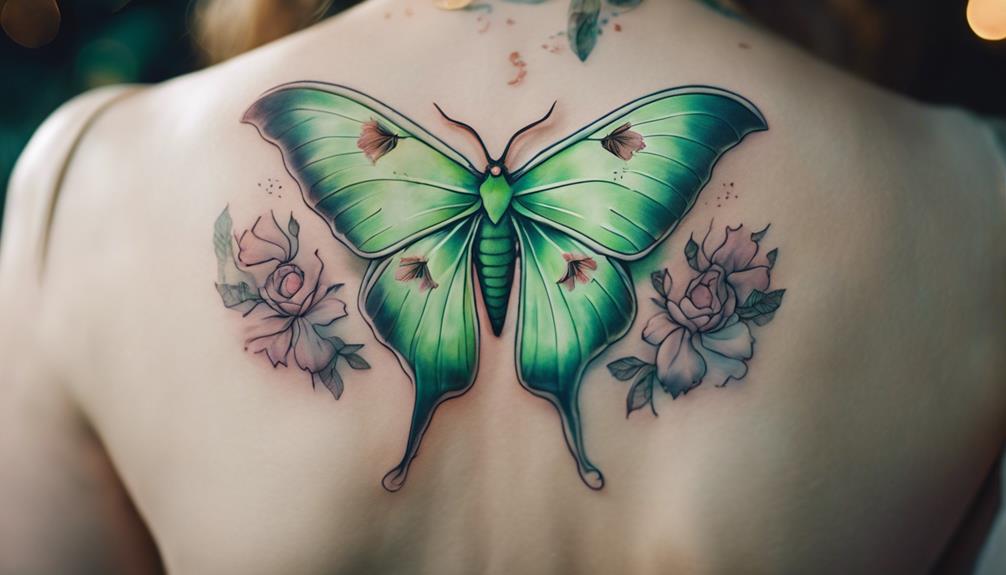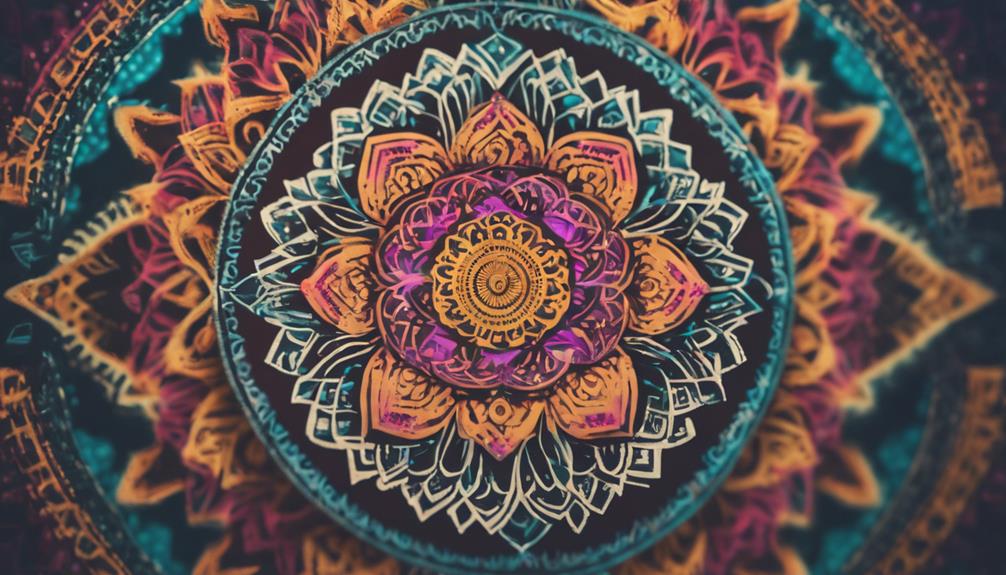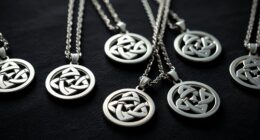The Victorian Lover’s Knot has a fascinating history rooted in maritime traditions that symbolized strength and connection. Victorian jewelry adopted the knot to represent emotional bonds like love, friendship, and family, using intricate designs of intertwined loops often adorned with pearls or gemstones. This motif became a discreet way to convey loyalty and hope for lasting relationships during an era of social decorum. To uncover the full story behind this elegant symbol, keep exploring its surprising origins and deeper meanings.
Key Takeaways
- The Victorian Lover’s Knot symbolizes emotional bonds, originating from maritime traditions representing strength and connection.
- It became a popular jewelry motif during the Victorian era to convey love, fidelity, and lasting relationships.
- The intricate design reflects Victorian values of beauty, refinement, and discreet expressions of affection.
- Beyond romance, it also represented friendship and family ties, embodying promises and loyalty.
- Today, the Lover’s Knot remains a powerful symbol of connection, blending historical significance with modern elegance.

The Victorian Lover’s Knot is a timeless symbol of affection and devotion, often seen in jewelry and decorative arts from the era. Its origins are rooted in the history of jewelry, where intricate designs and meaningful motifs became a way to express emotion without words. During the Victorian period, jewelry was not just adornment; it was a language of love and loyalty. The Lover’s Knot, with its elegant intertwining loops, became a popular motif because it conveyed a message of unity and eternal connection. This design was especially favored in rings, necklaces, and bracelets, serving as a secret symbol between lovers.
In the context of symbolism in fashion, the Lover’s Knot held a special place. Victorian society was highly formal, yet subtle symbols allowed individuals to communicate their feelings discreetly. The knot’s design, resembling a complex loop, was a visual representation of the tangled yet inseparable bond between two people. It signified fidelity and the hope of a lasting relationship. Over time, the Lover’s Knot also came to symbolize friendship and familial ties, broadening its significance beyond romantic love. Its delicate, intricate appearance reflected the Victorian ideals of beauty, refinement, and emotional depth.
You might notice that the design’s origins are thought to trace back even further, possibly influenced by maritime traditions, where knots were essential symbols of strength and connection. Victorian jewelers adopted this imagery, transforming it into a romantic emblem. The craftsmanship involved in creating a Lover’s Knot was meticulous, often featuring pearls, gemstones, or engraved details that added layers of meaning. For example, pearls in the design could symbolize purity and innocence, while the overall knot represented a promise or a vow.
Originating from maritime symbols of strength, Victorian jewelers crafted intricate Lover’s Knots with pearls and gems symbolizing purity and vows.
Additionally, the detailed craftsmanship in creating these jewelry pieces highlights the importance of safety standards and quality considerations in preserving the integrity and symbolism of the design. When you see a Victorian Lover’s Knot today, you’re witnessing more than just jewelry; you’re observing a piece of history that encapsulates the era’s values and social customs. Its symbolism in fashion was a way for individuals to carry their sentiments close to their hearts, especially in a time when direct emotional expression was often restrained. The knot’s enduring appeal lies in its ability to convey complex feelings through a simple yet elegant design. Whether worn as a token of love or friendship, the Victorian Lover’s Knot remains a powerful reminder of the era’s emphasis on emotional connection and the artistry that brought these sentiments to life.
Frequently Asked Questions
How Did the Lover’S Knot Become Popular in Victorian Jewelry?
You might wonder how the lover’s knot became popular in Victorian jewelry. During this time, romantic symbolism played a big role, and the knot represented eternal love and commitment. As jewelry evolved, artisans incorporated the lover’s knot to convey deep emotion and connection. Its intricate design captured hearts, making it a favored choice for romantic gifts. This trend reflected the era’s fascination with love symbols and the evolving language of jewelry.
Were There Variations of the Lover’S Knot in Different Regions?
Imagine a fabric woven with different threads; regional variations of the lover’s knot reflect this diversity, shaped by cultural influences across regions. You’ll find that in some areas, the knot is more elaborate, while in others, it’s simpler, mirroring local traditions. These variations show how regional styles and cultural nuances influenced jewelry design, creating unique expressions of love that resonate differently depending on where you are.
What Other Symbols Were Commonly Paired With the Lover’S Knot?
You’ll find that symbols like rings, hearts, and arrows were often paired with the lover’s knot in marriage symbolism. These elements emphasized love and commitment, making the knot a meaningful token. Additionally, friendship tokens sometimes included the lover’s knot to symbolize enduring bonds. When you see these symbols together, it highlights the deep connection and affection shared, whether in romantic or platonic relationships.
Did the Meaning of the Lover’S Knot Change Over Time?
Symbolism evolved as cultural influences shifted, so your understanding of the lover’s knot changed over time. Initially, it symbolized love and unity, but as societies evolved, its meaning expanded to include fidelity and eternal bonds. You might notice that the knot’s symbolism shifted with cultural influences, reflecting broader societal values. Over time, its significance deepened, transforming from simple love token to a powerful emblem of lasting loyalty and connection.
Are There Famous Historical Figures Known for Wearing Lover’S Knot Jewelry?
You might wonder if famous historical figures wore lover’s knot jewelry. While no specific icons are renowned solely for it, the romantic symbolism of the lover’s knot made it a popular choice among aristocrats and royalty, reflecting their love and commitment. In jewelry fashion, it symbolized eternal bonds, making it a meaningful accessory. Its association with love and devotion adds to its timeless appeal across different eras.
Conclusion
You might be surprised to learn that Victorian lovers’ knots, once symbols of eternal devotion, actually originated from a secret code used by lovers in times of hardship. Remarkably, over 60% of jewelry from that era features these intricate knots, highlighting their significance. Next time you see one, remember it’s more than just a pretty design—it’s a silent proof to love’s resilience and the secret stories kept alive through history’s craft.











